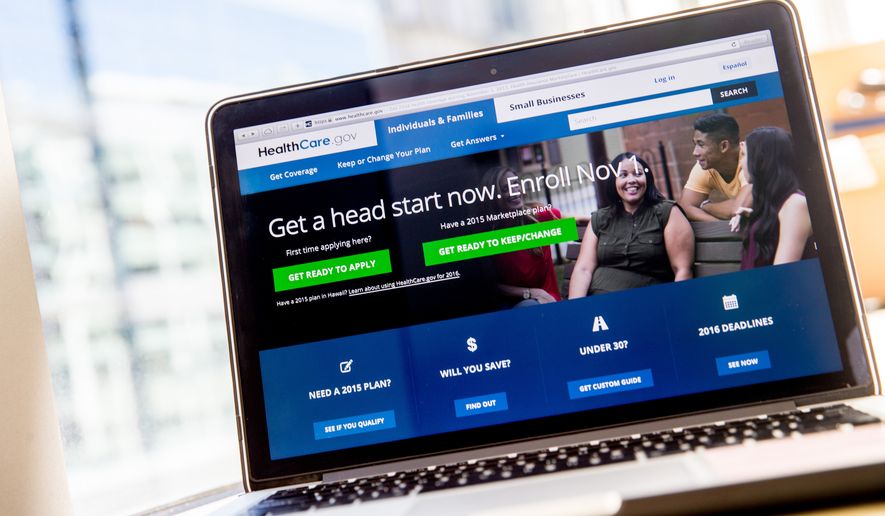Obamacare’s web exchanges are “vulnerable to fraud,” according to a watchdog report Monday that says government investigators were able to get taxpayer-subsidized coverage for fake enrollees despite a brand-new safeguard against chicanery on the law’s insurance exchanges.
The Government Accountability Office said six fictitious applicants who were able to obtain private coverage and subsidies under the Affordable Care Act during its testing in 2014 were successful again in 2016, even though none of the “enrollees” had filed a 2014 tax return.
The health law’s coverage provisions launched in 2014, and enrollees were supposed to file returns the following spring to make sure they received the correct amount of subsidy for their incomes. Those who failed to do so were supposed to lose their subsidies, beginning in 2016.
The GAO said that after a payment-processing error booted two of its fake enrollees, four of them were able to retain coverage — two filed paper forms that didn’t ask about the 2014 return, and two lied and said they’d filed returns.
The GAO said one of its lying customers had to verbally reassure a marketplace representative and then received a warning in May about filing a 2014 return, though coverage remained in place as of August.
“Our undercover testing for the 2016 coverage year found that the eligibility determination and enrollment processes of the federal and state marketplaces we reviewed remain vulnerable to fraud, as we previously reported for the 2014 and 2015 coverage years,” the GAO said.
The Centers for Medicare and Medicaid Services said it allowed filers to attest to filing their taxes, despite the new requirement, because of the lag time between when returns are filed and when the IRS sends data to the Obamacare exchanges.
However, it said it is reviewing eligibility after the fact, and those who were ineligible will receive warnings and lose their subsidies by October of this year.
Customers who received subsidies for several months up to that point will be responsible for reconciling their payments at tax time and paying back any illegal subsidies, the IRS told investigators.
The IRS said it had reservations about the attest-and-chase process, but that CMS made the decision.
The Congressional Budget Office estimates that subsidies and related spending under Obamacare will be $56 billion for fiscal 2017, then rise to $106 billion in fiscal 2026, totaling $866 billion for fiscal years 2017 through 2026.
Though the money doesn’t flow directly to enrollees, they do benefit financially through reduced monthly premiums or lower out-of-pocket costs.
“This report unfortunately tells us more of what we already know — that the Obamacare federal exchanges have been riddled with problems since day one,” House Ways and Means Committee Chairman Kevin Brady, Texas Republican, said. “The fact that the exchanges are so susceptible to fraud is just further proof that the president’s health care law is not working as promised — and wasting billions of taxpayer dollars in the process.”
The GAO said all 15 of its fictitious applicants were approved for taxpayer-subsidized coverage through the federal HealthCare.gov website in Virginia and West Virginia and California’s state-run exchange during the 2016 open enrollment period between Nov. 1, 2015, and Jan. 31. It submitted 14 applications for exchange coverage and 1 for Medicaid, the government-run insurance program for the poor.
Three were booted, however, when their initial payments wouldn’t go through, leaving the quartet from 2014 and eight new, fictitious enrollees on the exchanges.
Among those eight, seven were able to maintain subsidized coverage, mainly through trying to clear up inconsistencies on their applications in phone calls with exchange representatives. One enrollee through West Virginia lost coverage “after we failed — by design — to provide any documentation to clear an inconsistency, in this case regarding immigration status,” the GAO said.
The Health and Human Services Department says its security systems typically work the way they should, though it has asked the GAO to detail how it beat the system in 2016 and in prior years, saying it could help the agency shore up its vetting process. GAO investigators have refused.
“While the GAO has not provided details on the fictitious persons they used nor made recommendations to address the findings in this report, HHS continues to make ongoing improvements to strengthen program integrity efforts and Marketplace controls,” Jim R. Esquea, assistant HHS secretary for legislation, said in a letter to the GAO.
• Tom Howell Jr. can be reached at thowell@washingtontimes.com.




Please read our comment policy before commenting.